
IDEA DEVELOPMENT AND MODEL MAKING
CONCEPTS SELECTED, NOW IT WAS TIME TO DEVELOP THEM.
During the shortlisting process of this ideation period I did not have any real contact with users so did not get any 'relevant' feedback. During the research stage close contact was kept with manager and activity co-ordinator at a local elderly home and also with a fitness class for people aged 65+. Before starting to spend lots of time sketching it was a good idea to visit these invaluable sources to ask for feedback on the 4 concepts resulting from the shorlisting.
Concept 35 was the immediate controversial concept. The idea was influenced by a garden game (see here http://goo.gl/QBhRuv) Jumbo Speed Ball. The idea being that two users would be sitting on a chair with their legs raised in the air and then abduct their legs. Both the care home staff and the user group said that they would not like to use this product as it puts both the users in a very comprimising position that they (especially women) would not be comfortable in. They also had the concern that the users do not have enough muscle endurance to hold their legs in the air the entire time, or even have enough muscle strength to begin with to get the 'ball' from themselves back to the other user. After this vaulable insights it was decided that this concept would not be taken on to further develop.
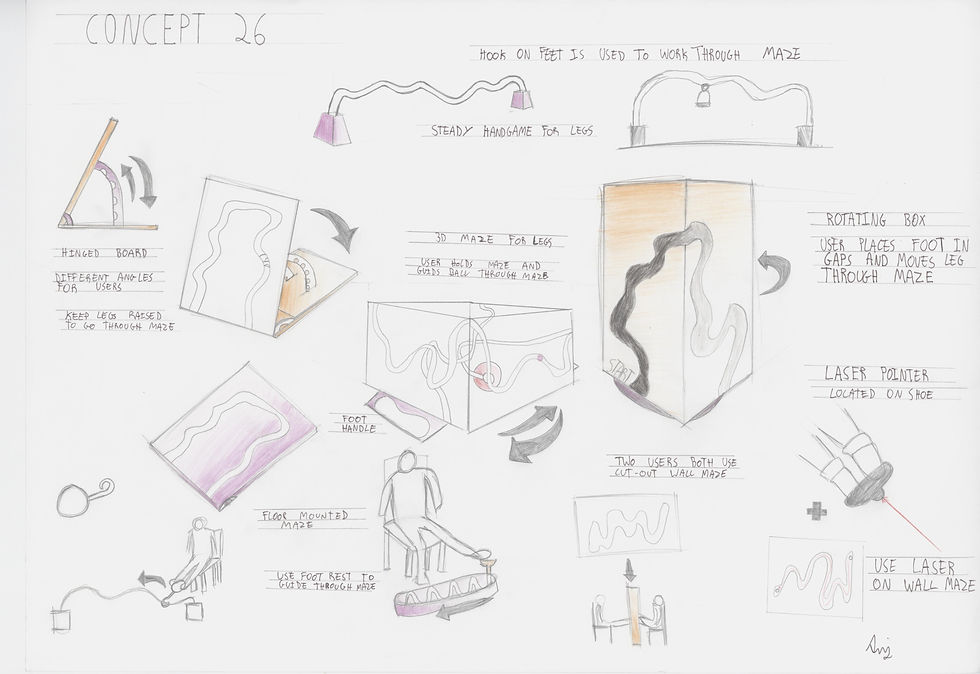

CONCEPT 26
Concept 26 was a twist on an already very popular game. The idea is based around the steady hand game (http://goo.gl/g8zrZC) but essentially swaps the use of hands for the feet. This encourages users to move their legs in up, down and sideway for a sustained period of time. Not only is the idea fun, it is also a tried and test game that people love that isn't hard to grasp.
Sketch variations to the left showed that the design could be on a wire similar to that found on the regular steady hand game. Other variations included a box that rotates around a fit point with the user having to move their feet through a cut out path in the cube. Another to include people who cannot lift their legs off the floor shows a cut out path for the user to follow thats angle can be adjusted to make the task easier or harder.

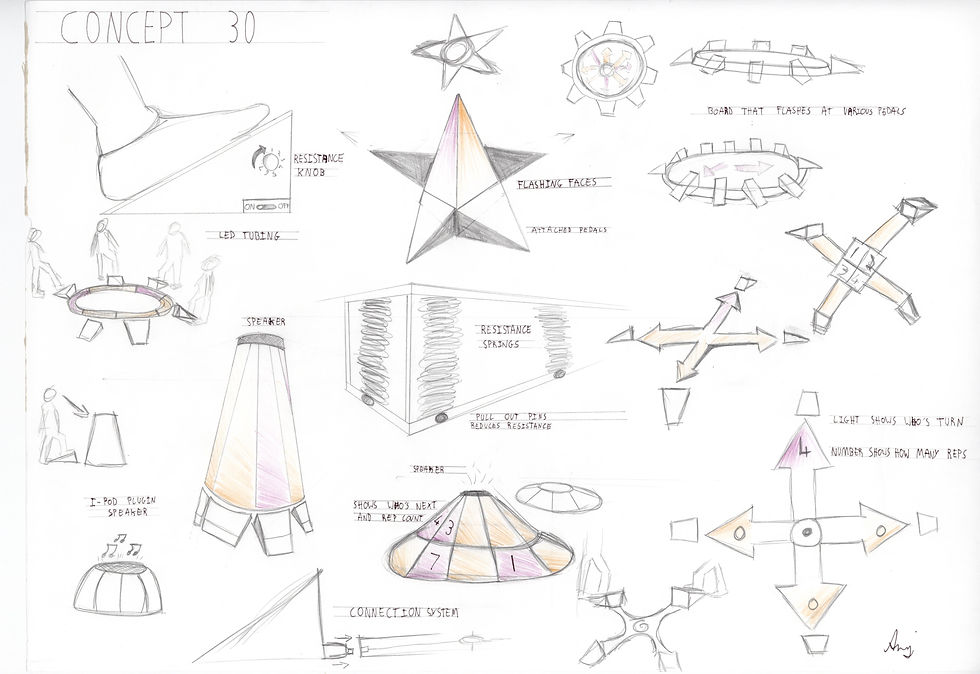


CONCEPT 30
This concept was based around the use of pedals/pressure pads to improve leg muscles. In the same way pumping up a tyre with a foot-pump, the pedals will force the users to improve leg muscles. The pedals will be used in a game situation. For example the sketches above show pedals that conduct a fair ground style game, where the harder you push down the higher the light will go on the bars. Another shows a spin the bottle type game were a light will randomly flash, for example 4 times and the user must push down on their pedal 4 times. Another possible game was a dice popper game (http://goo.gl/yUjSf7). The users would push down on their pedals to pop the dice and what ever number it lands on they then push the pedal that many times, then the next user takes over. A foot pinball game was also a very good potential for a product.
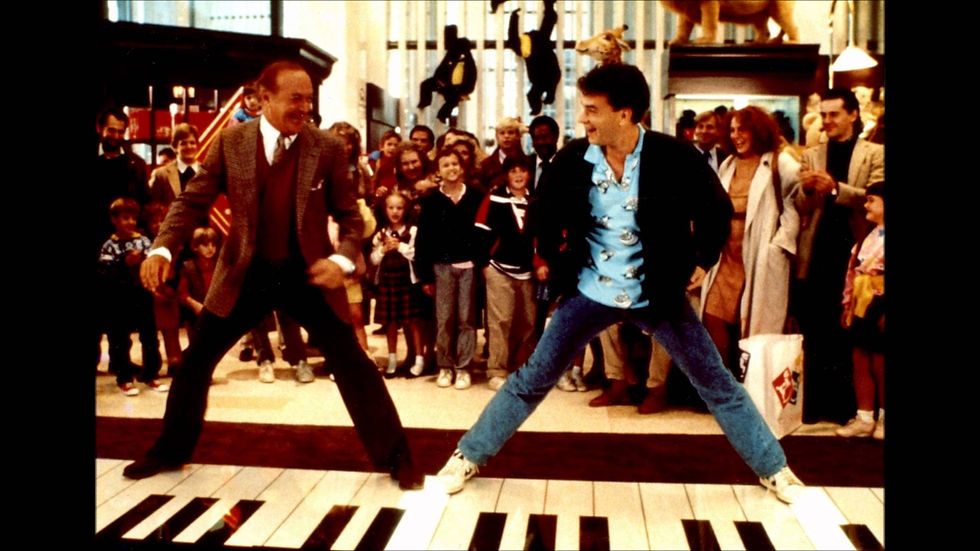


CONCEPT 30 - PIANO GAME
This specific idea was inspired by a friday night watching the film BIG. The piano scene inspired the idea that users have a set of pedals that act as piano notes. The pedals will then light up in random sequence for each of the users, this sequence will then play a well known song. The black pedal was originally going to be used to allow for a two different resistances but after model making it was best that it was used for a left foot pedal and the white key for a right foot pedal. The pedals connect to a central speaker hub that will play the song out loud, it also means that a varying number of people can use the product, not just the machines limit. This idea was very strong as it combines an integral part of exercising for elderly people (shown in research) in music and also social interaction.



CONCEPT 35
Concept 35 looked at the use of thera bands but in a social environment. Ballet bars were the main focus as people are more sociable when they are all stand near each other and can see what everyone else is doing rather than on seperate sides of the room as observed during research. Thera bands are a great resources for exercise as they are cheap, come at different resistance levels and can effectively exercie almost any muscle. Ideas were explored where thera bands would be on spring coil systems that come out of the ballet bar, with push buttons to increase or decrease the length, making it harder of easier for the user. Other ideas such as thera bands coming out of the wall came up along with a ballet bar that pushes away into the wall. One of the better ideas was a thera band tree (Thera-tree), this idea was simple. An organic shape has various different angle and height thera bands exuding from branches. The only flaw with this idea was that the base weight of the product would have to be very heavy in order to withstand forces pulling it upwards from several directions, which would mean it would not be portable. This idea was dropped.
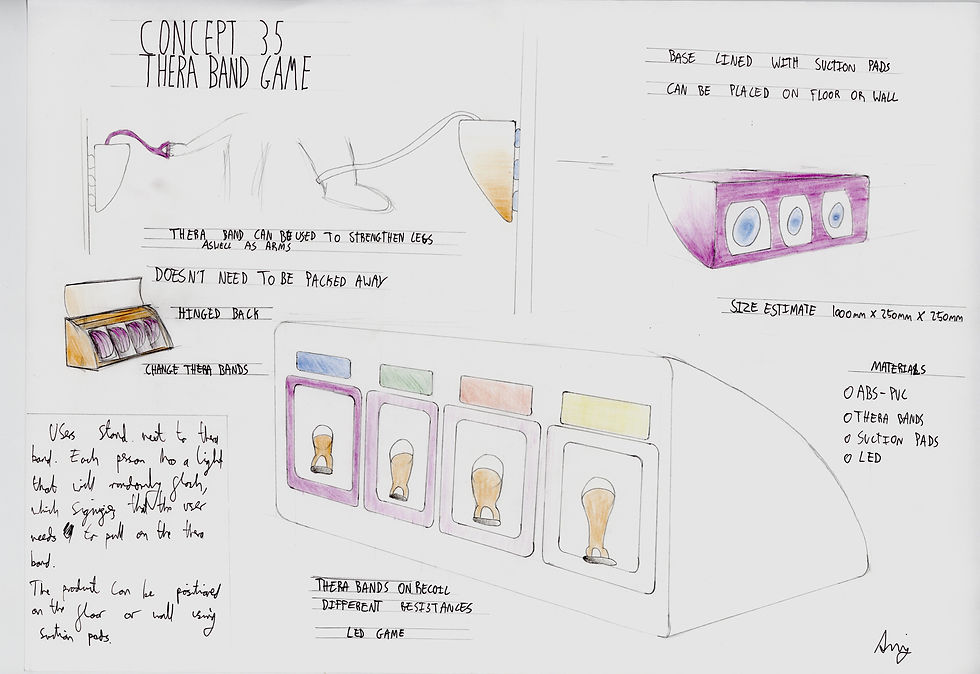

CONCEPT 35 - THERA BAND GAME
This game was slightly inspired by The Bleep Test (http://goo.gl/AC7JFf). The idea behind this is that each user will hold a thera band either with their hand or attached to their leg. Above each thera band is a light. The light will flash when the user needs to perform the activity. The light will flash with gaps between that gradually get smaller and smaller, thus giving the users less time to recover and also making them do more reps. The beauty about this product is that it can be position on the wall or floor. Using (strong) suction pads it can be position at different heights and angles so that users can train not only their leg muscles but arm muscles and abs too. The hinged back also allows the users the change the thera band in use to make the activity easier or harder depending on their independent levels. Although this product does not encourage social interaction in a more fun way than the piano game it does encourage it through a little bit of friendly competition, which in itself encourages social interactions. Friendly competitions was also an aspect that target users found keeps them entertained and coming back for more as well as the social aspect.
MODELS
The next stage was to build models to test these ideas and address and issues. Model Build Plans and Feasibility Test Plans can be found at the bottom of the Ideation home back (link at the bottom of the page) under the Appendix section.




CONCEPT 30 - PIANO GAME
There were several issues that came up with this Piano Game idea through model making. Firstly by making a very quick and crude model of what it would look like it became apparent through seeing a 3D object and feedback that firstly how would the user reach the black key pedal and how would it be able to work on a seperate mechanism. Secondly, would each user have enough space to potentially pull up a chair. The second model shows that the black key was moved next to the white key and they would each be used for the users seperate legs, ensuring the user did not favour one over the other. The problem of space was also addressed by reducing the number of pedal ports and by altering the central speaker hub. The next issue was the angle and hinging of the pedals. The initial design was to have a pedal similar to drum pedals, however after discussing this with the contacts in the carehome it became apparent that elderly people, who already have ankles, would simply just dorsi-flex at the ankle rather than user their whole leg to push down. This would not improve muscle strength and could cause serious injury. Using a foot pump model, angles were explored and it was determined that a pedal slightly angled, but not hinged at one eng that has to be 'pushed through' to work was the best way to ensure muscle strength would be gained.
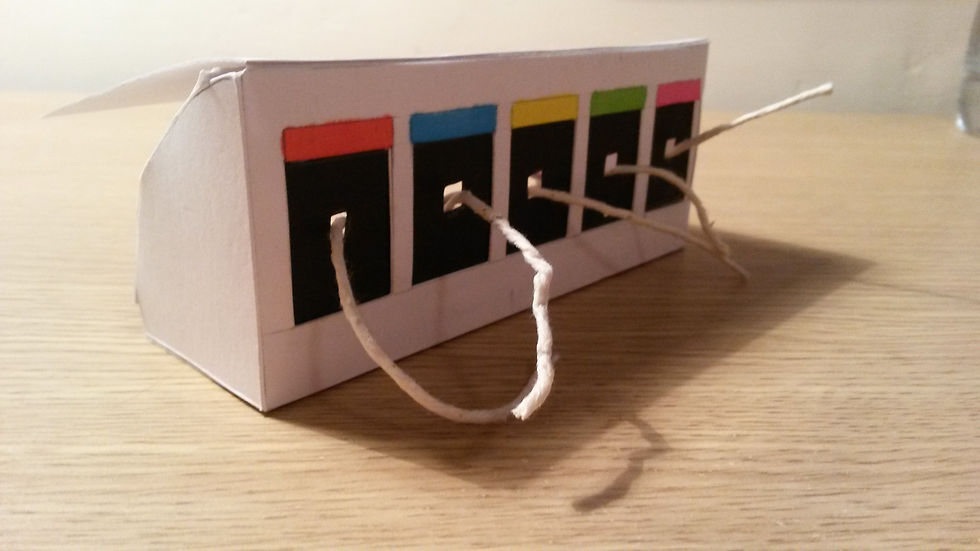

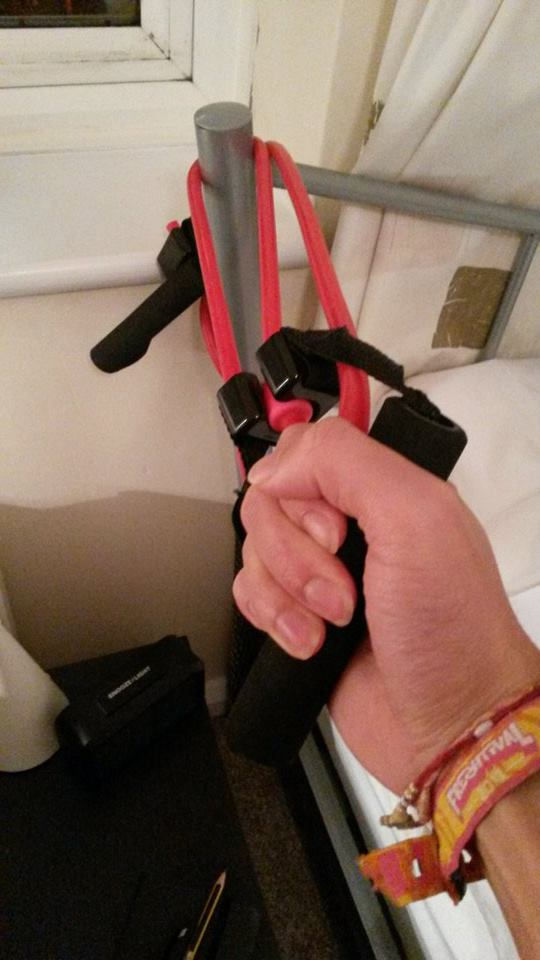

CONCEPT 35 - THERA BAND GAME
This concept was slightly harder to make models for as many of the factors that could cause potential product risk were things that would be tackled in the development stage. The first model looked at exploring the 3D shape of the product and where the hinged door would in fact go. The model was particularly useful looking at the space that would be available for the thera bands at the back of the product. It was also concluded that a touch-to-open system would be best to use to open the back casing as not only was it easiest for elderly people to use but also a lot safer as they would be less likely to get fingers caught. Whilst exploring the potential for suction pads to be applied to the base of the product it became apparent that the suction pads would have to be very strong in order to withstand the force of 4-5 people pulling in the opposit direction. In order to understand how strong the suctions pads would need to be a thera band was attached to a bed and pulled in an action that would be similar possible exercises to be performer. With fairly little force the thera band was able to start to move the whole bed. This raised the very large problem of first would the product even work and secondly would the safety of the users be at risk if they are able to pull the product clean off the surface. Serious injury could occur.
FEEDBACK
Concept 30 - Piano Game: After talking to carehome managers and activity instructors, user groups, peers and family it became apparent that this idea was very strong. The activity instructor said that combining music with an activity was essential during exercise for the elderly and that the cognitive sequence of piano notes and flashing lights would greatly appeal to alzheimers patients. They said the use of primary colours could be just as influential as the notes. Grandparents said that it was a thoughtful idea as it used technology in a snesible way, and did not alienate them. Constructive feedback included that the pedal lenght could be shorter and also designed more ergonomically.
Concept 35 - Thera Band Game: The care home manager was particularly concerned with this idea as he said that the amount of space needed between people to safely perform and exercise would need to be increase than what it was percieved to be on sketches and models. The issue of how strong the suction pads would need to be was raised as it was pointed out that it could not only do damage to the users but also to the environement e.g. walls and wooden floors. However he liked the idea of friendly competition as it would give the users a goal for each sessions, be it personally or focused at another user. Constructive feedback stated that could there be a noise as well as the flashing lights so it really was like a thera band bleep test.
FINAL DECISION
The final decision had to be made using not only facts but partly gut feeling. Both of these two developed ideas had strong basic concepts behind them but both had rather large flaws that would need to be addressed in the development process. The Thera Band Game concept provided friendly competiton whereas the Piano Game did not, however with the forces that would be applied to the Thera Band Game it would need suction pads too unreasonably strong. The Piano Game was not only a fun and interactive way of improving leg muscle strenght but was also easily transportable, easy to store, can be personalised using different songs and also can be played with a range of people. It also uses both legs simultaneously unlike the Thera Band Game and was a much safer design. Look over all the facts and feelings drawn from these products the decision was made that the Piano Game would be taken forward to the development stage.
